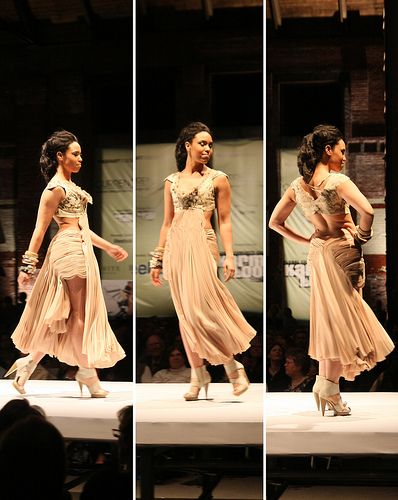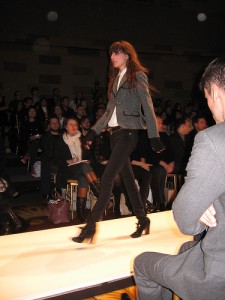Fuse Feature: Flash Back to Fashion Forward
Boston has a chance to stand alongside New York as a prominent fashion capitol. In a town rife with creative brains and ideas, designers here are as eclectic and innovative as counterparts around the globe. So let’s hope next year’s Boston Fashion Week will open its doors to a wider audience of non-fashion-snob-istas.

One of designer Samira Vargas's creations for the MASSART 2010 Fashion Show. Photo: Mauricio Tejerina
By Yumi Araki.
When the leaves turn orange, the leaders in the New England fashion world scramble to show their new collections, usually in competition with New York heavy hitters. My impression after attending shows here and in the Big Apple was, predictably, that the haute couture ensembles and glitzy, celebrity gowns of the New York fashion elite look avant-garde. But it was the emerging designers this year—both in New York and Boston—who carefully tailored and reinvented fresh approaches to the art of design.
In the face of jealous stares from veteran designers, select newcomers at New York Fashion Week (September 9–16) impressed critics with unexpectedly bold and ambitious aesthetics. Complementing the end of Fashion Week, The New Yorker Festival hosted “Fashion Forward” (October 2), featuring an international cast of designer panelists who shared pioneering revelations about fashion’s future. Boston’s own Fashion Week, which ended last week (September 23–October 1), featured local talent who left strong impressions that Boston’s burgeoning fashion scene was in full swing.
Each emerging designer contributed to defining the emerging trend of progressive fashion: aesthetics inspired by geometry, architecture, and history, and by preserving a garment’s purity by self-owning and hand-crafting the brand.
A young designer who created buzz at New York Fashion Week was 25-year-old Julian Louie, a former architecture student whose signature esoteric designs caught the eye of Francisco Costa of Italian Vogue. Drawing from Victorian design and architectural aesthetics, Louie also pays homage to his Californian roots with his unique scuba-gearesque fabrics. In his New York Magazine profile, Louie explains that he strives to separate himself from other young designers (namely, instant-celebrity, Project Runway-contender types), by keeping his brand self-owned, which enables the young designer to maintain creative control over his pieces.
Every designer panelist at “Fashion Forward,” also expressed the importance of preserving the “authenticity” of their work by keeping brands independent of larger design firms. Indian designer Naeem Khan, whose signature opulent evening wear showed at New York Fashion Week, stressed that it was only after his brand became self-owned that he was able to fully harness his designs, intricately modern, geometric patterns inspired by traditional Indian motifs.
Another designer who incorporated geometry into his collection was Phillip Lim, who also spoke about the importance of versatile design. Presenting a playful collection of trapezoid-patterned, wool outfits inspired by pop-rock icon Blondie, Lim’s winter stadium jacket looked like a tastefully layered vest and sweater ensemble. Lim explained that his goal was to create pieces that make the wearer look purposely uniform, and that “the layers” provided the illusion of additional bang-for-your-buck amid a recessionary market.
Taking their brand name from 16th-century scrap dealers who converted junk to fabrics and glues, rag & bone designers David Neville and Marcus Wainwright presented their collection, which is aptly targeted towards young professionals rather than wealthy socialites. Paying homage to British explorers in their fall and winter collection, the award-winning British designers drew much inspiration from their country’s history. In 2002 the body of a British mountaineer George Mallory, who set out on a Mt. Everest expedition in 1924, was found with his clothing intact, which became the narrative spine of Neville and Wainwright’s collection. The duo resurrected the explorer’s royal British expedition romanticism with tailored tweed jackets and exquisite clothing that arduously preserved the brand’s passion for hand-made garments.

The rag & bone runway, catwalk show during 2007 Fashion Week New York at Gotham Hall. Photo: Jennifer Jackson
More hand-made garments were shown at this year’s Boston Fashion Week, where designers collaborated with local boutiques, spas, clubs, and museums to showcase their collections. One had to disregard the rah-rah of the chi-chi party events in order to keep your eye on the designers’ works, but many made promising impressions. Much like New York’s Julian Louie, Michael De Paulo, a fellow former architect, showed his mermaid-silhouetted evening gowns at Boston’s Liberty Hotel. Custom sewn to fit the wearer’s exact dimensions, De Paulo’s patterns are inspired by shadows and other images from nature. Another promising dual-background designer, Samira Vargas, a 31-year-old security guard and College of Art and Design senior from the Dominican Republic, melds her eclecticism into her ruffled skirts and dresses.
Boston has a chance to stand alongside New York as a prominent fashion capitol. In a town rife with creative brains and ideas, designers here are as eclectic and innovative as their New York or Parisian counterparts. Let’s hope that next year’s Boston Fashion Week will open its doors to a wider audience of non-fashion-snob-istas.


